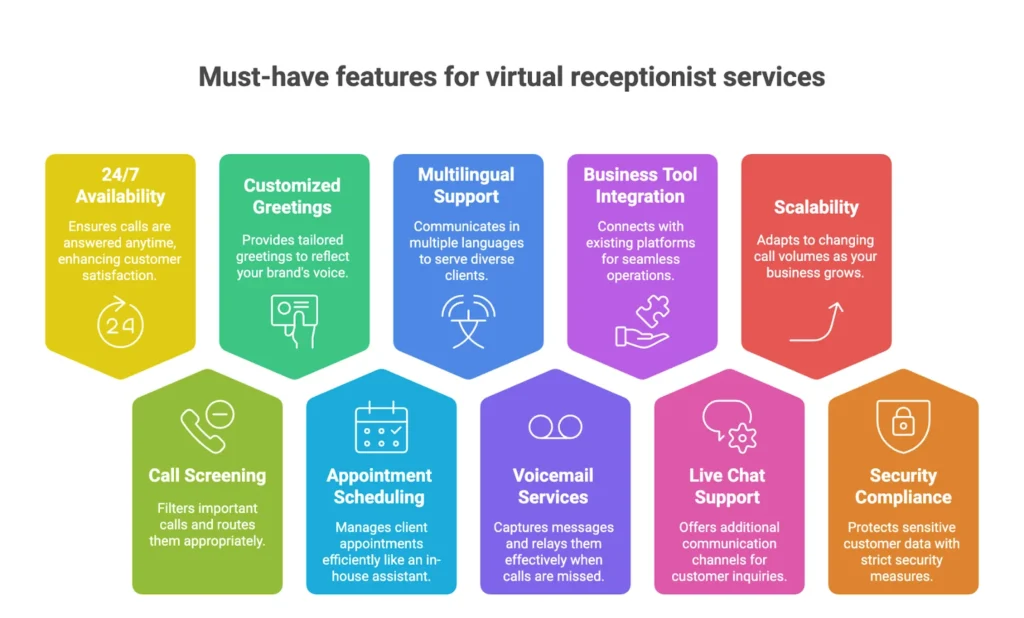Your phone rings nonstop—customers with questions, appointment requests, and urgent matters that can’t wait. But you can’t be everywhere at once. A virtual receptionist service ensures your business stays responsive without pulling you away from high-priority tasks.
The right virtual answering service for small businesses does more than just pick-up calls. It provides a seamless customer experience, keeps operations running smoothly, and even helps capture new opportunities. However, not all services are created equal. Here are ten must-have features to look for when choosing a 24/7 virtual receptionist.
1. 24/7 Availability
Customers expect immediate responses, even outside standard business hours. A virtual receptionist service should provide around-the-clock coverage to handle calls at any time of the day or night.
Key benefits:
- Prevents missed opportunities by ensuring every call is answered.
- Increases customer satisfaction by providing real-time support.
- Supports businesses with global clients across different time zones.
This feature is particularly critical for service-based businesses, legal firms, healthcare providers, and e-commerce companies that deal with time-sensitive inquiries.
2. Call Screening and Forwarding
A well-structured call routing system ensures that important calls reach the right person while filtering out spam or non-urgent inquiries.
Look for services that offer:
- Intelligent call screening to differentiate between sales calls, client inquiries, and urgent requests.
- Customizable call forwarding rules, such as forwarding only during specific hours or based on caller type.
- Voicemail-to-email options for non-urgent messages that don’t require immediate attention.
This ensures your team stays focused on priority calls without being distracted by unnecessary interruptions.
3. Customized Greetings and Call Handling
A virtual receptionist should sound like an extension of your brand, not just an outsourced answering service.
What matters here:
- Custom greetings tailored to your business tone and customer expectations.
- Branded call-handling scripts to ensure every caller gets a professional and consistent experience.
- Call escalation options for urgent matters requiring immediate action.
A generic greeting like “Hello, how can I help you?” isn’t enough. A good service should offer branding consistency, like:
“Thank you for calling [Your Business Name]. How may we assist you today?”
4. Appointment Scheduling
For businesses that rely on client appointments, a virtual receptionist should handle scheduling as efficiently as an in-house assistant.
Key features to look for:
- Integration with calendar systems (Google Calendar, Outlook, CRM tools).
- Ability to reschedule and cancel appointments based on predefined rules.
- Automated appointment reminders via phone, text, or email to reduce no-shows.
Industries like healthcare, legal, real estate, and home services benefit most from this feature.
5. Bilingual and Multilingual Support
Language barriers can lead to lost customers. If your business serves a diverse community, having a virtual receptionist who can communicate in multiple languages is a competitive advantage.
Key benefits:
- Enhances customer experience by reducing miscommunication.
- Expand your reach to non-English-speaking clients.
- Helps businesses in multicultural markets build trust and credibility.
At a minimum, look for services that offer English and Spanish support, as they cover a large portion of the U.S. market.
6. Voicemail and Message Taking
Even with 24/7 coverage, there are times when a voicemail might be necessary. A good virtual answering service for small businesses should provide multiple ways to capture and relay messages.
Essential capabilities:
- Voicemail transcription for easy reading and quick response.
- Message delivery via email or SMS to ensure you stay informed.
- Custom voicemail options for after-hours or specific call types.
This ensures that even if a call isn’t answered in real-time, important information is captured and delivered to the right person.
7. Integration with Business Tools
A virtual receptionist service should seamlessly integrate with the platforms you already use.
Look for compatibility with:
- CRM systems (HubSpot, Salesforce, Zoho) to track customer interactions.
- Zapier integrations to connect with over 3,000 apps, automating workflows across multiple platforms.
- Booking software (Calendly, Acuity Scheduling) to manage appointments.
The fewer manual tasks required, the more efficiently your business runs.
8. Live Chat and Email Support
Phone calls aren’t the only way customers reach out. A robust virtual receptionist service should extend support to live chat and email for a complete customer service experience.
Why it matters:
- Improves response time across all communication channels.
- Offers a text-based alternative for customers who prefer non-verbal interactions.
- Streamlines issue resolution by providing consistent messaging across platforms.
Multi-channel support is crucial for e-commerce, SaaS, and service-based industries.
9. Scalability for Business Growth
Your call volume may change depending on the season, promotions, or business expansion. The right virtual receptionist service should be flexible and scalable to adjust to your needs.
What to consider:
- Ability to handle increased call volume without extra infrastructure.
- Options for adding more receptionists as your business grows.
- Short-term scaling for peak seasons like holidays or product launches.
A service that can scale with your business prevents bottlenecks and ensures continuous customer satisfaction.
10. Security and Compliance
If your business handles sensitive customer data, security is non-negotiable. A virtual receptionist service should follow strict compliance standards to protect customer information.
Key security measures:
- HIPAA compliance for healthcare-related businesses.
- PCI compliance if handling credit card transactions.
- GDPR adherence for businesses with European customers.
Ask potential service providers about their data protection policies to avoid legal risks.
Next Steps
Now that you know what to look for, it’s time to take action:
✔ Assess your business needs: Identify the top challenges your receptionist service should solve.
✔ Compare providers: Shortlist companies that meet your key requirements.
✔ Test before committing: Use free trials or demos to evaluate real-world performance.
Choosing the right virtual answering service for small businesses isn’t just about answering calls—it’s about optimizing customer interactions, saving time, and driving business growth. Make an informed decision, and you’ll see the difference in efficiency and customer satisfaction.







